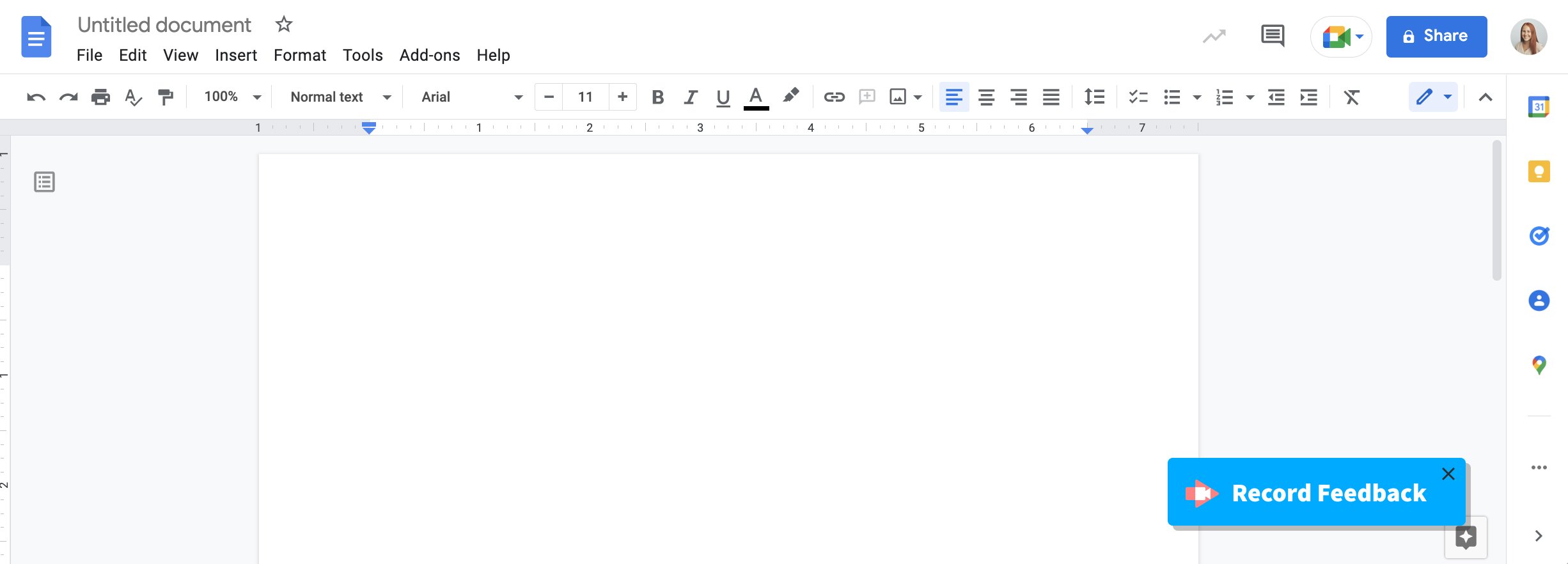
Feedback Tool
Feedback is one of the most important ways for teachers to help students improve their work. When provided via a screencast video, feedback becomes even more relevant, engaging, and actionable. This project will build a video feedback experience into Google Docs and Google Classroom designed to streamline the experience of recording, sharing, and watching a video for teachers and their students.
Hypothesis: Showing a “Record Feedback” button on Google Docs/Classroom will increase usage of record through the use case of providing student feedback.
🔬 Research Plan
🥅 Goal
The overall goal of creating a Feedback Tool is to increase the usage of record.
We believe there is a large opportunity to increase the number of videos users are creating by introducing (or encouraging) the use of Screencastify as a tool for feedback.
In order to validate our hypothesis, we will conduct two phases of research:
POC Experiment: Show a “Record Feedback” button on Google Docs and measure its usage. (Validate: Does this placement and functionality increase usage of record)
User Survey: Quantify the behavior and expectations of this button. (Validate: Are users using this button in the way we intend them to)
POC Experiment
Before building the full ideal flow (large scope), is there a lightweight POC we can build to validate if users have an appetite for initiating a recording from this placement?
⚖️ Metrics
Of users that see this button, how many use it to record a video? And how many times do they do this?
Need to measure:
How many users see the button?
Docs vs Classroom views
How many users click on the button once?
How many users click on the button more than once?
🧪 Experiment Design
What: A “Record Feedback” button will be shown on Docs. Clicking this button will start a screen recording with mic and webcam; clicking the button again will end the recording and open the VMP as with a normal recording
Who: Select group of districts will be given access
Do we want to focus on Classroom districts (next test)?
Two groups: Experiment group and control group:
Prior to experiment, we will pull baseline usage data for both groups
Build a dashboard/report to track this data week to week
Results and Key Findings
📈 POC Results
Key Takeaways:
Of the users who did try the button, 22% had repeat interactions
Anywhere from 2-25% of users that saw the button actually clicked on it (approximate guess based on incomplete GA/Pendo data)
Experiment Segment:
27 Districts/Accounts enabled
13k district teachers total
4.5k average unique monthly users
2.1k unique users last month
From Pendo Data, Feb 15 - March 1 2022 (2 week period)
Button Shown: 2283 visitors have seen the button
2% Click Rate: 45 visitors
22% Repeat Usage: (10 of the 45 clicked)
21% Dismissed: 484 visitors
📝 Survey Results
Overall, regardless of whether the user clicked or not, there is an interest in providing video feedback. The main pain points/reasons why teachers don't currently record video feedback is that it is too time consuming.
Why users clicked on the button:
To record video feedback
Quicker way to start recordings
Why users didn’t click on the button:
Don't provide feedback via video (too time consuming, prefer written/live feedback) 67%
Didn't understand what the button did 25%
Other- Didn’t have enough time 8%
More than half of users say they already do/would like to record more feedback via video (54%)
33% said they realistically do not have time
13% said they don’t see themselves recording video feedback
Next Steps
Run the same test in Google Classroom and compare data
Broader roll-out without changes to UX to collect more clarifying data
Potential downsides - users not seeing value in first use, preventing from future use
Should this be a limited feature
Release to a wider audience (start with paid users or domains)
Create Pendo guide to pop-up for user feedback
Main areas of opportunity:
Survey of Edtech influencers - video feedback as a growing use case
Explain the intended use case
Expedite the whole process (pre and post recording) to save teachers time
Provide a way for users to turn it on/off


